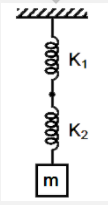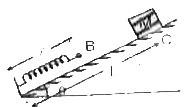A spring-block system undergoes vertical oscillations above a large horizontal metal sheet with uniform positive charge. The time period of the oscillations is T. If the block is given a charge Q, its time period of oscillation will be
T
>T
<T
>T if Q is positive and <T if Q is negative
The correct Answer is:A
To solve the problem, we need to analyze how the time period of oscillation of a spring-block system is affected when the block is given a charge Q while it is oscillating above a large horizontal metal sheet with a uniform positive charge.
1. Understanding the System:
- We have a spring-block system oscillating vertically above a charged metal sheet. The sheet has a uniform positive charge.
2. Initial Time Period:
- The time period of oscillation for a spring-block system is given by the formula:
T=2π√mk
where m is the mass of the block and k is the spring constant.
3. Effect of Charge on the Block:
- When the block is given a charge Q, it experiences an electric force due to the electric field created by the positively charged metal sheet. The electric field E due to an infinite sheet of charge is given by:
E=σ2ϵ0
where σ is the surface charge density and ϵ0 is the permittivity of free space.
4. Force on the Block:
- The electric force Fe acting on the block due to the electric field is:
Fe=Q⋅E
- This force will add to the gravitational force acting on the block.
5. Effective Gravitational Force:
- The effective gravitational force Feff acting on the block when it has charge Q becomes:
Feff=mg+Fe=mg+Q⋅E
6. Impact on Time Period:
- The time period T of the oscillation depends only on the mass m and the spring constant k, and is independent of the gravitational force acting on the block. Therefore, even though the effective gravitational force changes due to the electric force, the time period remains:
T=2π√mk
7. Conclusion:
- Since the time period T is independent of the gravitational force (and thus the electric force), the time period of oscillation after the block is given a charge Q remains the same as the initial time period T.
Final Answer:
The time period of oscillation remains the same, i.e., T.
- We have a spring-block system oscillating vertically above a charged metal sheet. The sheet has a uniform positive charge.
- The time period of oscillation for a spring-block system is given by the formula:
T=2π√mk
where m is the mass of the block and k is the spring constant.
- When the block is given a charge Q, it experiences an electric force due to the electric field created by the positively charged metal sheet. The electric field E due to an infinite sheet of charge is given by:
E=σ2ϵ0
where σ is the surface charge density and ϵ0 is the permittivity of free space.
- The electric force Fe acting on the block due to the electric field is:
Fe=Q⋅E
- This force will add to the gravitational force acting on the block.
- The effective gravitational force Feff acting on the block when it has charge Q becomes:
Feff=mg+Fe=mg+Q⋅E
- The time period T of the oscillation depends only on the mass m and the spring constant k, and is independent of the gravitational force acting on the block. Therefore, even though the effective gravitational force changes due to the electric force, the time period remains:
T=2π√mk
- Since the time period T is independent of the gravitational force (and thus the electric force), the time period of oscillation after the block is given a charge Q remains the same as the initial time period T.
The time period of oscillation remains the same, i.e., T.
Topper's Solved these Questions
- ELECTRIC CHARGES AND FIELDSBOOK - AAKASH SERIESCHAPTER - ELECTRIC CHARGES AND FIELDSEXERCISE - Exercise-II
56 Videos
- ELECTRIC CHARGES AND FIELDSBOOK - AAKASH SERIESCHAPTER - ELECTRIC CHARGES AND FIELDSEXERCISE - Practice Exercise
57 Videos
- ELECTRIC CHARGES AND FIELDSBOOK - AAKASH SERIESCHAPTER - ELECTRIC CHARGES AND FIELDSEXERCISE - Assess Your Self
13 Videos
- DUAL NATURE OF RADIATION AND MATTERBOOK - AAKASH SERIESCHAPTER - DUAL NATURE OF RADIATION AND MATTEREXERCISE - PRACTICE EXERCISEX
42 Videos
- ELECTRIC FIELD AND POTENTIALBOOK - AAKASH SERIESCHAPTER - ELECTRIC FIELD AND POTENTIALEXERCISE - PROBLEMS (LEVEL-II)
26 Videos
Similar Questions
Knowledge Check
Time period of oscillation of a spring is 12 s on earth. What shall be the time period if it is taken to moon?
A6 sB12 sC36 sD72 s
A simple pendulum oscillates slightly above a large horizontal metal plate. The bob is given a charge. The time period
View SolutionWhen a boy is playing on a swing in the sitting position , the time period of oscillations of the swing is T. If the boy stands up , the time period of oscillation of the spring will be
View SolutionThe time period of oscillations of a simple pendulum is 1 minute. If its length is increased b 44% then its new time period of oscillation will be
View SolutionTime period of oscillation for given combination will be :

View SolutionA system is shown in the figure. The force The time period for small oscillations of the two blocks will be

View SolutionA block of mass 'm' is released on the top of a frictionless incline as shown in the figure. The time period of the oscillation of the block is

View SolutionA block of mass m hangs from a vertical spring of spring constant k. If it is displaced from its equilibrium position, find the time period of oscillations.
View Solution


_S01_040_Q01.png)